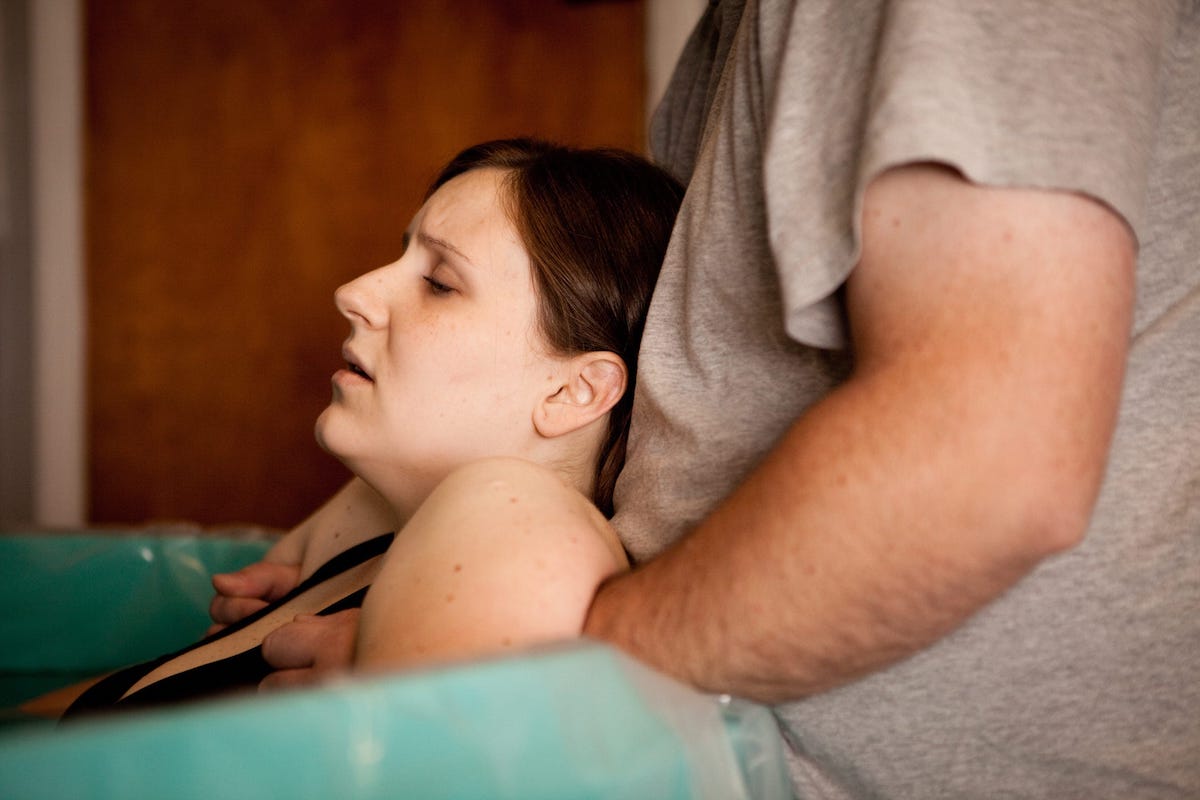I left Chicago in 2014 to move to Brown and there were many wonderful things about that move, but one that was sad was leaving my set of mom friends: Jane, Elena, Katie and Heather. There is something about the crucible of having had babies at the same time that you can never replicate. The people who saw you with breastmilk and sweat stains everywhere; the people who brought you food and held your baby while you took a shower; the people who visited you in the NICU. I miss them all the time.
Many of these women make appearances in Expecting Better, including Katie Kinzler, who very alert readers may recall as the person who asked about Hot Yoga safety. When she is not engaging in hot yoga, Katie is a Professor of Psychology at the University of Chicago. Her work is mostly with young kids, and it’s totally fascinating as both a researcher and a parent.
In particular, she works on issues around language: how kids process foreign language speakers, and basic issues of language and identity. She also works on kids and food, although that’s not the topic here!
For many years I have been after Katie to write a book, so I am delighted that she did it, and it’s out tomorrow. How You Say It (Buy it Here!) is about how we talk, what it says about us, about bias and racial cues and bilingualism. It’s exactly the book I wanted from her. So I thought I’d check in with her about why she wrote it (and also take the chance to ask whether social isolation is bad for my kids.) Check out our conversation below.
My research as a developmental and social psychologist shows how kids see language as providing this incredible amount of social meaning. But, a lot of the relevant literature is in neighboring fields – sociolinguistics and psycholinguistics, anthropology, education, law; among others. So at first, I thought about writing a book that was just geared toward academics, uniting these fields.
But I quickly realized that the issues I am touching on are so personal for so many people’s lives. Issues such as how language becomes critical for your identity, your social connections, your morality – and when and why people discriminate against others based on their speech. So, I wanted to think broader than just academics and have a dialogue with people.
And, the following is going to sound cheesy because I am writing this in your newsletter – though I swear you did not ask me to say this, and I don’t believe I’ve ever actually told you this – Emily, you were a bit inspirational. J
I remember a moment when my daughter Taylor was a baby, and my husband and I talked to a speech language pathologist. We were exposing Taylor to two languages (English and French). As you know, she was born early (but fortunately healthy, and today she is an amazing 6-year-old). At the time, the advice we got was to consider just exposing her to English. The idea was if your kid has a risk of a language delay, it may be better to just focus on one language.
This advice feels kind of intuitive to hear, but it is also unsubstantiated. In fact, research shows that kids of all different abilities can learn more than one language.
At the time I was in the midst of working on research showing that just being exposed to a foreign language can have social benefits for kids, and I felt that bilingualism was the right choice for my family. And I thought to myself, “hmm if Emily were here, she would probably dig in to the research and share her insight with the world!”
In all seriousness, I think language is personal to a lot of people. The way you speak can give you insight into who you are and who other people are too. It can cause people to connect, but it can also cause them to discriminate and divide. Yet, we aren’t always aware of the importance of language for our lives and the lives of others. We are especially unaware of the social consequences of speaking in what is seen by others as a stigmatized or non-standard dialect. Speech impacts people’s social connections and economic opportunities in life and we need to become more aware of this.
Another aspect of the book is how social biases are inadvertently transmitted to kids via our language, which a lot of parents are interested in learning about and trying to correct where they can.
In the first half of the 20th century there were a bunch of “scientific” studies purporting to find that kids who were learning two languages were less intelligent than the monolingual kids. But, these studies were flawed. Basically they revealed some racism and xenophobia – where researchers were testing whether immigrant populations were “less intelligent” than those who had been native to the (predominantly white, English-speaking) countries.
Modern science sets the record straight that there is no cognitive handicap caused by learning multiple languages – and if anything, current-day research hints at potential benefits of multilingual exposure.
A little bit of exposure can be a great thing! Though it doesn’t have to be French, and it certainly doesn’t have to be in a formal “class.” Any exposure to people who speak in different ways can be a positive for children’s development.
Imagine the cognitive and social intrigue of being a bilingual child. You think about who knows what, and who speaks what to whom, and who understands what content. You might think “Oh, Grandma speaks this way and Dad but not Mom understands.” Or “We speak English at school and Spanish at home.” Or, “I understand this relative, and so do my parents, but my best friends have this other language and understanding.” Or “We all understand these two languages, but we use them in different spaces.” And so on. Basically, whatever your situation is you get this huge training in “perspective taking.” Monolingual kids miss out on this particular facet of social life experience.
Some of my research and that of others shows that when kids get this practice in linguistic perspective taking by being exposed to more than one language, it spills over into other domains. They become better at perspective taking more generally, which is a hallmark of effective communication and interpersonal understanding. And these benefits accrue even if the children are only exposed to another language and are not bilingual themselves.
One thing I think a lot about is how unaware we are of linguistic biases – both as parents and as a society. The fact that we (and children!) judge each other based on our speech just isn’t on our radar to the extent it should be.
Another thing parents may want to know more about is the way the words we use can inadvertently convey biases to kids. This could either be about learning about a new social category of people that kids haven’t thought of before (and the prejudices that can come along with that), or it could be about increasing the salience of a category that kids already think about.
One example is about how language inadvertently influences gender bias. The general idea is that when we constantly label gender – “Boys and girls line up;” “Oh what a nice little boy;” “You’re the only girl cousin!” – this has an impact. It’s not to say we can never talk about gender. However, when kids hear language about gender all day every day, they start to think, “Oh ok – this must be *the* most important category, since adults are talking about it all the time!” And then they start becoming more likely to look for stereotypes about gender in their social worlds.
Though, there is some nuance. I’m not saying never talk about gender, or other categories. Especially in the case of race, it’s also important to know that “colorblind parenting” is not the answer. Pretending that race doesn’t exist, in an environment steeped in structural racism, doesn’t work. Kids are like intelligent cultural sponges who absorb the world around them, and in today’s racist society they will notice race whether or not you talk about it. So, you need to talk about race. But you want to do so in a way that provides context and explanation, and not just category labels.
I’ll share an anecdote, and why I think it illustrations something scientifically important.
The anecdote: What was one of the most upsetting aspects of the social isolation for my daughter? All the normal social isolation stuff, not seeing friends or family, living with stressed out parents, etc.? Sure. But what was *really* upsetting was the day that she found out that a bunch of her Kindergarten friends had a Zoom dance party without her. So small, but so painful, right?
The science: Humans are incredibly attuned to social rejection and loneliness. Being excluded feels terrible, and social pain shares a lot of the same neural signatures as physical pain. But it turns out that a lot of our social feelings exist in our minds, and not always in reality. What I mean by that is that one person could be physically alone, and feel connected. Someone else could be surrounded by friends and family, and feel lonely and isolated. Furthermore, a lot of your thinking about your social lives is comparative with others – so if you feel like you are as socially connected as other people are, this feels good.
In a virtual world, as my daughter experienced, you can still feel rejected. Yet more generally, your kids can be home and socially isolated, yet appreciate that it is not because they are rejected. So even if kids’ social contact is minimal, parents can aim to do whatever they can to make kids feel “part of a group.” If kids know that their feelings and experiences are just like those of the other kids, this can help. As a result, children may be socially isolated, but they may not necessarily feel as lonely as they would otherwise.
Community Guidelines

















Emily:
I’m excited to talk about your book. Let me start with a general question: why did you decide to write this? You’re a professor at Chicago and writing books for popular audience is not the most common Professor thing to do. I realize it’s a bit of a rich question coming from me but… what motivated you to do this?